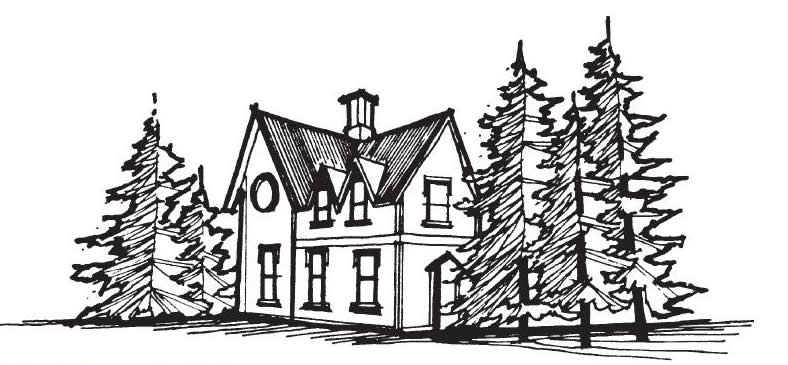
Landscape plants can accentuate the architectural style of your home. The branching pattern and general shape of certain trees or shrubs can reflect the attractive structural shapes of your home to create a harmonious landscape.
When selecting the dominant plants for your landscape, consider the shapes of your home that you would like to accent.

Figure 1. Plant and house forms are in harmony.
Illustration by Janice A. Cervelli (get permission)
Landscape plants can be positioned to draw attention to the main entrance or other prominent parts of the home.
Frame your home by placing the tallest trees away from the home and progressively shorter plants closer to the entrance. This creates a more welcoming effect and can reduce the boxy appearance of square buildings.
Well-planned placement of landscape plants can also form “windows” to the property. By allowing your home to be seen only from the most alluring angles, you can create a sense of curiosity in the viewer.
Even more important than the view of your home are the views you will have from the windows of your home. Consider where you will spend the most time looking out your windows, and think about what you would like to see from those windows.
An all too common landscaping mistake is to place plants in spaces that they will eventually outgrow. The most common example occurs when trees or shrubs are planted too closely to a house. When these plants reach large sizes, they “crowd” the building and make it appear smaller.
Just as your kitchen, bedroom, and garage are all distinct spaces with distinct purposes, outdoor rooms also serve specific purposes.
Imagine the types of activities that you expect to take place in your yard. These activities might include:
Reading
Sunbathing
Gardening
Grilling
Entertaining
Painting
Building projects
Lawn games
Children’s play
Yard maintenance
Many of these activities could take place within the same outdoor room, while others may require their own designated space.
Outdoor rooms are not only functional, but they add interest to the landscape. By creating distinct spaces, you can avoid having one continuous, dull space.
Consider the desired features of the spaces where these activities will be conducted. For example, would you need sun or shade; privacy or a view; soft grass or a hard surface?
Also consider whether it should be outwardly oriented or inwardly oriented. Outwardly oriented rooms have limited enclosures. The viewer’s gaze is often drawn toward attractive features outside the room, such as ornamental plant displays or a scenic natural view.
Rooms that require privacy or minimal distraction tend to be inwardly oriented. Walls of inwardly oriented rooms create a partial or complete screen. For example, shrubs with open growth habits create a partial screen while tall, dense evergreens used with other trees and shrubs create a strong enclosure.
Inwardly oriented rooms also tend to have a central focal point such as a sculpture, an ornamental tree, or a large potted planting.
You can use a combination of various living and non-living materials to create outdoor spaces that meet your needs. Examples of materials are listed below.
Outdoor walls:
row of ornamental grasses
shrub hedge
row of large potted plantings
grouping of small ornamental trees
raised beds
wooden fence
stone or brick wall
Outdoor floors:
stone, brick, or wooden patio
lawn
ornamental groundcovers
garden beds
stepping stones
mulch
crushed rock
Outdoor ceilings:
pergola
tree canopy
One important design principle is the concept of rhythm. Rhythm exists when certain features such as shape, color, or texture, are repeated with slight variations in their pattern.
These variations add interest to the landscape. However, variations that deviate significantly from the pattern can dominate the landscape or cause tension for the viewer.
For example, attempts to implement multiple unique plant species may disguise the underlying pattern and create a sense of chaos. For this reason, it is best to avoid using too many different plant species in one design.

Figure 2. A strong focal point exists amongst repeated colors, textures, and forms. A limited number of plant species are used in this design.

Figure 3. These few added focal points do not follow any pattern. Instead, they create an unattractive, cluttered design.
Much of the content on this page is adapted from “Landscape Design with Plants: Creating Outdoor Rooms” by Janice A. Cervelli, University of Kentucky